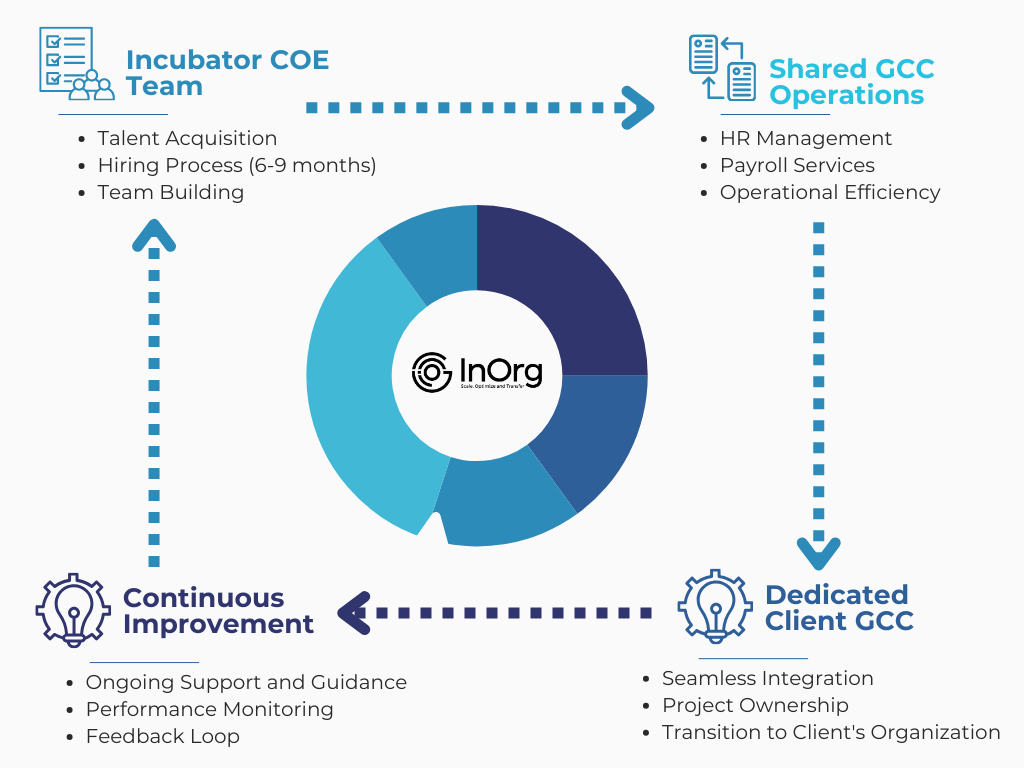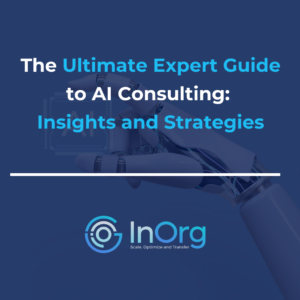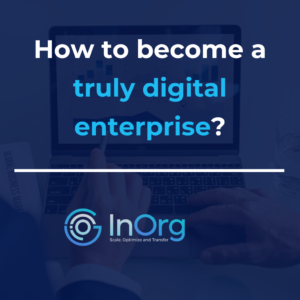With advancements in technology and shifting market demands, the landscape of project management continues to evolve. As companies strive to stay competitive and innovative, the need for effective project management solutions has never been more critical. When it comes to managing tech projects, there are several approaches available. Among the most common are Staff-Augmentation, System Integrators, and the Global Capability Centers. Each of these options offers unique benefits and challenges, catering to different project requirements and organizational goals.
Choosing the right project management approach is necessary for ensuring project success. The decision can significantly impact factors such as project timeline, budget, quality of deliverables, and overall client satisfaction. Therefore, it’s essential to carefully evaluate each option and select the one that aligns best with the project’s objectives and constraints.
Understanding Staff-Augmentation-Model
Staff augmentation is a way to hire temporary workers with specific skills for projects. It helps businesses meet project needs. This model is particularly popular in the IT industry. IT staff augmentation services help businesses fill skill gaps without the long-term commitment of hiring full-time employees.
Staff augmentation firms provide these temporary staff. They offer a wide range of expertise, from entry-level positions to senior roles. The staff augmentation model is highly flexible. It allows businesses to scale their teams up or down depending on their current needs.
Here’s a quick overview of what staff augmentation entails:
- Temporary hiring of skilled professionals
- Flexibility in scaling teams
- Filling skill gaps
- Reducing long-term hiring commitments
Agency Involvement and Its Impact on Project Accountability
Agency involvement in staff augmentation can have implications for project accountability. While agencies play a crucial role in sourcing and providing talent, their level of accountability for project outcomes may vary. In some cases, agencies may prioritize fulfilling staffing requirements over ensuring project success, leading to a lack of accountability for deliverables and timelines. It’s essential for organizations to establish clear expectations and communication channels with agencies to ensure alignment on project goals and accountability for outcomes.
System Integrators
Systems Integration (SI) is another approach to managing IT needs. It involves integrating disparate systems to work as a cohesive unit. System Integrators play a crucial role in this process. They ensure that all systems, software, and processes work together seamlessly.
System integration services are particularly important for large-scale IT projects. They help businesses streamline their operations and improve efficiency.
Here’s a quick overview of what systems integration involves:
- Integrating disparate systems
- Ensuring seamless operation of all systems
- Streamlining business operations
- Improving efficiency
Advantages of Systems Integration
The process of integrating systems provides numerous advantages. It enables businesses to optimize their operations, resulting in enhanced efficiency and productivity. This approach guarantees the smooth collaboration of all systems. Additionally, systems integration aids in reducing operational expenses for businesses.
When should you choose systems integration?
Choosing systems integration depends on several factors. If your business uses multiple systems that need to work together, SI might be the right choice. It’s also a good option if you’re looking to streamline your operations.
Choosing systems integration (SI) is essential under several circumstances:
– Multiple Systems Interaction: If your business operates with multiple systems that need to communicate and function cohesively, SI can synchronize these systems to work as a unified entity.
– Operational Streamlining: SI is beneficial for businesses looking to enhance efficiency by streamlining operations and reducing redundancies.
– Large-scale IT Projects: For major IT initiatives, SI ensures that various technological components integrate smoothly, supporting scalable and robust IT architecture.
Benefits of Systems Integration Offshoring:
1. Cost Efficiency: Offshoring can significantly reduce labor and operational costs due to lower wages in certain countries.
2. Access to Specialized Skills: It allows access to a broader pool of skilled professionals worldwide, who may possess niche skills not readily available domestically.
3. Round-the-clock Productivity: Leveraging time zone differences, offshoring can enable continuous work cycles, speeding up project timelines.
Challenges of Systems Integration Offshoring:
1. Cultural and Communication Barriers: Differences in language and culture can lead to misunderstandings and communication lapses, affecting team dynamics and project clarity.
2. Quality Control Issues: Maintaining consistent quality standards across geographies can be challenging, especially when managing teams remotely.
3. Data Security Risks: Offshoring increases the risk of data breaches and intellectual property theft, given the broader exposure to varying regulatory standards.
4. Dependency and Scalability Concerns: Over-reliance on offshore teams might pose risks if geopolitical issues or economic instability affect the offshoring location. Moreover, scaling operations may require additional oversight and integration of new teams.
By understanding when to choose systems integration and recognizing the benefits and challenges of offshoring SI, businesses can make informed decisions that align with their operational needs and strategic goals.
The InOrg Model: Redefining Tech Project Execution
The InOrg Model stands apart from traditional staff augmentation and system integrators by offering a comprehensive, lifecycle approach to project management. Unlike staff augmentation, which provides temporary resources, or system integrators, which focus on end-to-end solutions, the InOrg Model emphasizes the creation of dedicated Global Capability Centers and long-term partnership with clients, ensuring continuity, accountability, and exceptional results throughout the project lifecycle.
- Incubator Center Of Excellence Team:
In this initial phase, InOrg sets up an Incubator Center of Excellence (COE) team tasked with sourcing and hiring the talent that will form the backbone of the GCC. This meticulous process typically spans 6-9 months, ensuring the selection of the most qualified individuals aligned with the client’s needs.
Meanwhile, to kickstart project operations swiftly, InOrg deploys a shared GCC team. This InOrg-owned team facilitates rapid deployment and covers operational functions until the client’s GCC team is fully onboarded. Throughout this phase, InOrg retains full ownership of the teams involved.
- Shared GCC Operations:
With the GCC established, InOrg assumes responsibility for operating and managing shared GCC operations seamlessly. This encompasses various functions such as HR, payroll, and overall operational efficiency, ensuring uninterrupted project flow and client satisfaction. This phase extends for up to three years, during which InOrg maintains ownership and oversight.
- Talent as a Service:
Once the GCC is fully operational and the client’s team is established, InOrg transitions to providing Talent as a Service. The entire team, now integrated into the client’s organization, assumes ownership of the project, seamlessly taking over from the Incubator COE team.
Accountability and Project Ownership
Staff-Augmentation vs System Integrator vs InOrg Model
| Aspect | Staff-Augmentation | System Integrator | InOrg Model |
| Ownership and Accountability | Limited accountability for project outcomes. | Generally responsible for project delivery but may vary. | Full ownership and accountability throughout the project lifecycle. |
| Scalability | Offers flexibility in scaling workforce as needed. | Easily scalable up/down as per project requirements. | Scalable with dedicated Global Capability Centers (GCCs) for long-term sustainability. |
| Expertise | Access to specialized skills on a temporary basis. | Offers specialized expertise for end-to-end solutions. | Focuses on building dedicated teams with top-tier talent aligned with client needs. |
| Control and Communication | Limited control over project timeline and quality. | Varies in quality control and communication. | Maintains control over operations and ensures seamless communication. |
| Cost-effectiveness | Cost-effective for short-term projects. | Costs may vary depending on project scope and quality. | Offers long-term value with dedicated teams and streamlined operations. |
| Project Integration | External staff may struggle to integrate into company culture. | May face challenges in cultural integration. | Seamless integration into client’s organization with Talent as a Service approach. |
| Long-term Sustainability | Limited long-term sustainability due to temporary nature. | Varies based on contract duration and client relationship. | Provides sustainable solutions with dedicated GCCs and ongoing support. |
One of the hallmarks of the InOrg Model is our emphasis on accountability and project ownership. Throughout the project lifecycle, our dedicated GCC teams take full responsibility for project outcomes, ensuring alignment with client goals and objectives. This commitment to accountability drives excellence and fosters long-term success.

Decision-Making Framework: Selecting the Right Model
When deciding on the appropriate project management model, several key considerations come into play:
- Ownership and Accountability: Evaluate the level of ownership and accountability required for the project. Staff augmentation offers flexibility but may lack accountability, while system integrators vary in their level of responsibility. The InOrg Model provides full ownership and accountability throughout the project lifecycle.
- Scalability: Consider the scalability needs of the project. Staff augmentation allows for temporary scaling, while system integrators offer scalability based on contract terms. The InOrg Model provides scalable solutions with dedicated Global Capability Centers (GCCs) for long-term sustainability.
- Expertise: Assess the need for specialized skills and expertise. Staff augmentation offers access to temporary expertise, while system integrators provide end-to-end solutions. The InOrg Model focuses on building dedicated teams with top-tier talent aligned with client needs.
- Control and Communication: Evaluate the level of control and communication required for project success. Staff augmentation and system integrators may face challenges in quality control and communication. The InOrg Model maintains control over operations and ensures seamless communication throughout the project.
Project-Specific Factors to Evaluate
In addition to the key considerations mentioned above, it’s essential to evaluate project-specific factors such as:
- Project Complexity: Assess the complexity of the project and the level of expertise required for successful execution.
- Timeline: Consider the project timeline and the need for flexibility in scaling resources as per project milestones.
- Budget: Evaluate the budget constraints and the cost-effectiveness of each project management model.
- Organizational Culture: Take into account the organizational culture and the ability of external teams to integrate seamlessly into the company culture.
Cost-Effectiveness and Long-Term Sustainability
Finally, consider the cost-effectiveness and long-term sustainability of each project management model. While staff augmentation may offer short-term cost savings, the InOrg Model provides long-term value with dedicated teams and streamlined operations. Assess the overall return on investment and the ability of each model to meet the project’s objectives in the long run.
Final Thoughts:
As we look ahead to the future of tech project management, it’s clear that innovative approaches like the InOrg Model are poised to play a significant role. By prioritizing accountability, scalability, and long-term sustainability, InOrg’s approach offers a compelling solution for organizations seeking to streamline their project execution processes. With dedicated Global Capability Centers and a client-centric mindset, InOrg is reshaping the landscape of tech project management, driving efficiency, and delivering exceptional results.
As organizations continue to embrace digital transformation and seek agile solutions, the InOrg Model stands ready to meet the challenges of tomorrow head-on, ushering in a new era of project management excellence.





